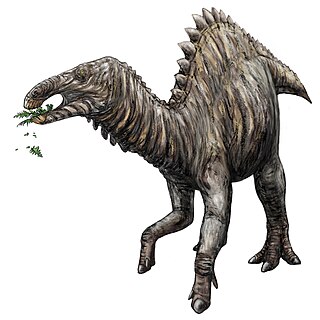
The Hepialoidea are the superfamily of "ghost moths" and "swift moths".

Tanius is a genus of hadrosauroid dinosaur. It lived in the Late Cretaceous of China. The type species, named and described in 1929 by Carl Wiman, is Tanius sinensis. The generic name honours the Chinese paleontologist Tan Xichou. The specific epithet refers to China. In 2010 Gregory S. Paul estimated the length of Tanius at 7 metres (23 ft) and its weight at 2 metric tons.
Zhang Haitao is a Chinese football coach and former player. He spent his whole career with the Shandong Team before he retired and moved into youth management with the Shandong Luneng youth team. He then moved into senior management with the Chinese women's football team before returning to Shandong, where he is the assistant manager.

Shandong Molong Petroleum Machinery Company Limited, or Shandong Molong, is a private petroleum machinery manufacturer in Shouguang, Shandong, China. It offers oil well pump, sucker rods, oil well pipes and other oil drilling and oil extraction machinery products. Petrochina and Sinopec are its major customers.

Dolichoderus is a genus of ants found worldwide.
Alloiomma is an extinct genus of ants that once belonged to the subfamily Dolichoderinae. A. changweiensis was the first extinct species to be discovered by Zhang in 1989, and another fossil species was discovered in 1994, known as A.differentialis. The ants were endemic to China.
Elaphrodites is an extinct genus of ants of the subfamily Dolichoderinae. Two fossils were discovered and described by Zhang in 1989.
Myopopone sinensis is an extinct species of ant in the genus Myopopone. Fossils were discovered in 1989 in China, and was later described by Zhang in that year.
Iridomyrmex shandongicus is an extinct species of ant in the genus Iridomyrmex. Described by Zhang in 1989, fossils were originally found in 1989, and out of all the fossils in the genus, this one has strongest support that it belongs in the genus.
Dolichoderus jiaoyanshanensis is an extinct species of ant in the genus Dolichoderus. Fossils containing the species were found in China, and it was described by Hong in 1985. The ant is from Shanwang and is presumed to be a Miocene insect.
Dolichoderus lacinius is an extinct species of Miocene ant in the genus Dolichoderus. Described by Zhang in 1989, fossils of a queen specimen were found in China.
Dolichoderus luridivenosus is an extinct species of Miocene ant in the genus Dolichoderus. Described by Zhang, Sun and Zhang in 1994, the species was discovered after a fossil of a queen was found in China.

Dolichoderus sibiricus is a species of ant in the genus Dolichoderus. Described by Emery in 1889, the species is endemic to China, North Korea, Japan, Mongolia, South Korea and Russian Federation.
Dolichoderus transversipetiolaris is an extinct species of Miocene ant in the genus Dolichoderus. Described by Zhang, Sun and Zhang in 1994, the species was discovered after a fossil of a queen was found in China.
Liometopum eremicum is an extinct species of Miocene ant in the genus Liometopum. Described by Zhang in 1989, the fossils were found in China.
Liometopum lubricum is an extinct species of Miocene ant in the genus Liometopum. Described by Zhang, Sun and Zhang 1994, the fossils were found in China.
Liometopum potamophilum is an extinct species of Miocene ant in the genus Liometopum. Described by Zhang in 1989, the fossils were found in China.
Tapinoma baculum is an extinct species of ant in the genus Tapinoma. Described by Zhang in 1989, fossils of the species were found in China.

Laiyangosaurus is a genus of saurolophine hadrosaurid from the Late Cretaceous Jingangkou Formation of China. It is known from one species, L.youngi, found in the Laiyang Basin within the province of Shandong.
Sinankylosaurus is a genus of dinosaur, originally described as an ankylosaur, from the late Cretaceous Period of Shandong, China. The genus contains a single species, Sinankylosaurus zhuchengensis, known from a nearly complete right ilium. The describers claim that the discovery of Sinankylosaurus further demonstrates the similarity between dinosaurs of eastern Asia and western North America.





